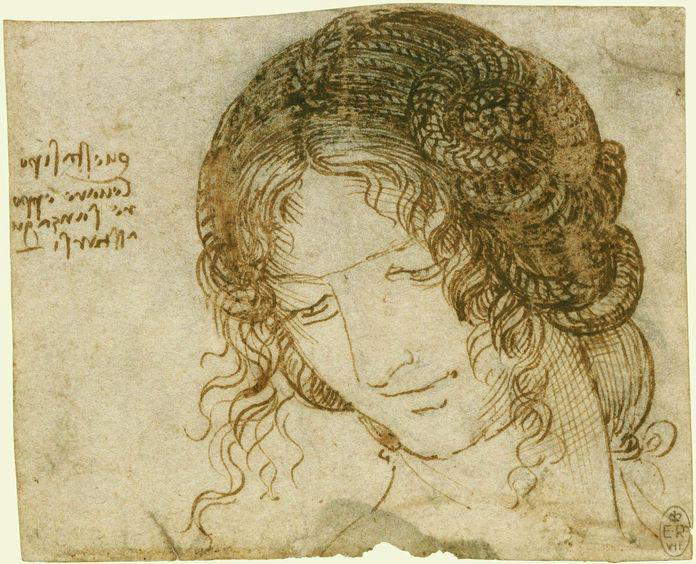The TV series Leonardo, dedicated to the adventures (it has to be said, because the story is fictional) of Leonardo da Vinci (Vinci, 1452 - Amboise, 1519), played by Irish actor Aidan Turner, has received a reception between lights and shadows, although more shadows than lights (the far-fetched details for a story set in the late 15th century, the often banal dialogues, the plot especially at the beginning very slow and therefore tiring to follow: these are aspects we have extensively discussed on these pages). Part of the audience, however, appreciated the performance of the young Bologna actress Matilda De Angelis, who in the fiction plays Caterina da Cremona, the woman around whom the whole story revolves. In the fiction, Caterina da Cremona is a friend of Leonardo da Vinci’s who is found murdered, and the artist is among the suspects: interrogated by an official of the duchy of Milan, Stefano Giraldi (a fictional character played by Freddie Highmore), Leonardo begins to tell the story of his life, from his first meeting with Caterina that took place in the workshop of Andrea del Verrocchio.
The question that all viewers of the screenplay will have asked themselves at least once is: did Caterina da Cremona really exist? The simple answer is: no, Caterina da Cremona is a fictional character. But in reality, the creation of this character revolves around a real name attested in a source (albeit not a primary one), that of a certain "Cremona, " a figure totally unknown to Leonardo studies until 1982, when the Scritti sulle arti (Writings on the Arts ) by Giuseppe Bossi (Busto Arsizio, 1777 - Milan, 1815), an important neoclassical painter, secretary of the Brera Academy of Fine Arts from 1801 to 1807, and a great devotee of Leonardo da Vinci, was published. The edition of Bossi’s papers was edited by Roberto Paolo Ciardi, who published much unpublished material, and among the unpublished writings was a note in which Bossi wrote: “That Leonardo [...] loved pleasures, is proved by a note of his concerning a courtesan called Cremona, a note communicated to me by an authoritative person. Nor would it have been possible, that he had thoroughly known men, and human nature, to represent it without, by long practice, tinging himself somewhat with human weaknesses. This has happened to all the greatest and deepest knowers of men; nor do I think it possible without this to master them, or imitate them either by writing or painting.” Reading between the lines, on the shaky foothold of this note Bossi probably imagined a relationship between Leonardo da Vinci and this "Cremona,“ justifying it on the basis that a great connoisseur of human beings such as the Tuscan artist was should also know ”human weaknesses" by having practice in them.
 |
| Leonardo da Vinci (Aidan Turner) and Caterina da Cremona (Matilda De Angelis) in the Leonardo series. Photo Fabio Lovino |
And on the basis of this writing by Bossi, therefore, an attempt has been made to force the idea that Leonardo may have had amorous or erotic relationships with women: the truth is that we have no certain news of his intimate ties with female persons, while the same cannot be said of his relationships with men. But who was this “Cremona” of whom the sources seem to be silent? Unfortunately, since we do not know Bossi’s source, we cannot know: Charles Nicholl has tried to imagine that Bossi received the news from someone who frequented the Biblioteca Ambrosiana, where several Leonardian papers are preserved (and this someone may have been, according to the scholar, the librarian Carlo Amoretti). The vicissitudes that the Ambrosiana underwent during the Napoleonic occupation of Milan, however, do not help to dispel doubts, as the institution was looted and much material was lost. Even Carlo Pedretti, who tried to imagine a relationship between Leonardo and Cremona, was convinced that the solution on the figure of this courtesan (to this day, however, not yet found) should be sought in the Ambrosiana, but not only.
The great Leonardist was particularly elated at the possibility of attributing to Leonardo an affair with a prostitute, which Pedretti intended to substantiate, in a 1996 paper of his own, on the basis of the “extraordinary fact” that must have been the note mentioned by Bossi (“a document of enormous importance for Leonardo’s biography,” which resurfaced “after almost two centuries of oblivion”). It was, first of all, to be able to imagine a Leonardo unknown to studies, and then to confirm the importance of automimesis (identification with the passions he studied) for his research. “Leonardo’s note concerning the woman who, as Dante put it, had procured him ’marvelous graces,’ is not found in any of the manuscripts known today,” Pedretti premised. “It should be borne in mind, however, that the information communicated to Bossi by an ’authoritative person’ could refer to some of those manuscripts, once in the Ambrosiana and which after the Napoleonic strippings had to undergo mutilations only partially ascertained. [...] There always remains, however, the possibility of Leonardo’s papers known at the time of Bossi and then disappeared, and after all, one of the goals of his travels was precisely to follow the trail of lost vinciani autographs, or to question people who had access to them. And it cannot be ruled out that among his still unpublished papers is to be found the text of the report received by him.” Pedretti also went so far as to imagine that the papers attesting to Leonardo’s possible amusements with the courtesan might have been deliberately expunged by someone in the course of history, the Ambrosiana being a religious institution (but it was the same scholar who acknowledged, in this case, that he was “working from imagination”).
 |
| Leonardo da Vinci, Study for the Head of Leda (c. 1505-1506; pen and ink, 92 x 112 mm; Windsor, Royal Collection, inv. RCIN 912515) |
In short, according to Pedretti, Cremona must have been an active prostitute in Rome in the second decade of the sixteenth century, at the time of Leonardo da Vinci’s stay in the city (between 1513 and 1516), and she must have practiced her profession with her name of origin, as was customary for women who practiced her trade (“It is well known that Rome,” the scholar wrote, “was the paradise of prostitutes, and this from the time of Petrarch.”). But what was the note Bossi referred to supposed to prove? According to the scholar, the “first-hand document” was supposed to corroborate the idea that “Leonardo frequented a whore” (“I prefer the Dantean term to the euphemistic courtesan,” Pedretti wrote), known, “as was the custom of the time, by the name of the city of origin: the Cremona.” By the time of his stay in Rome, Leonardo had passed the threshold of sixty and was welcomed into the Vatican Belvedere by Giuliano de’ Medici, brother of Pope Leo X. Here, two of his German assistants had set up a mirror workshop, where, however, the intentions, according to Pedretti, would have been anything but scientific. And in this workshop perhaps Leonardo had his models pose, making them wear wigs: in a sheet preserved in the Royal Collection in Windsor, number 12515, one can see a study for Leda with a handwritten note by Leonardo, which says “Questa si po levare e porre sanza guastarsi” referring to the wig, as if, Pedretti speculated, “Leonardo himself had it made for his model (what if it were La Cremona?).”
The drawing, however, is usually dated to before the Roman sojourn (Pedretti also mentions it with a date of 1508-1510), but according to the scholar this would not prevent one from thinking of a Leonardo who was able to continue his studies on Leda even in Rome, perhaps making use of “La Cremona” as a model. Pedretti, in the same essay, gives an account of a Vatican codex that records a “Maria Cremonese” who was a “cortesana” in Rome at the time of Leonardo’s stay: of course, however, this is information on the basis of which nothing can be attributed to Leonardo. In short: what we know about the “Cremona” is third-hand information reported for the first time three hundred years after the events, as well as the name of a certain Maria di Cremona who was engaged in meretriciousness in Rome at the time of Leonardo, but which is currently impossible to connect with the “Cremona” of Bossi’s note. Of course, it cannot be ruled out, as Pedretti and Nicholl have speculated, that Bossi’s informant had had access to the papers in the Ambrosiana before the devastating occupation by the French: at the moment, however, nothing more grounded has yet emerged. The Caterina da Cremona of the TV series (half invented name, totally invented character) is therefore based on a suggestion.
 |
| Leonardo TV series: did the figure of Catherine of Cremona really exist? |
Warning: the translation into English of the original Italian article was created using automatic tools. We undertake to review all articles, but we do not guarantee the total absence of inaccuracies in the translation due to the program. You can find the original by clicking on the ITA button. If you find any mistake,please contact us.